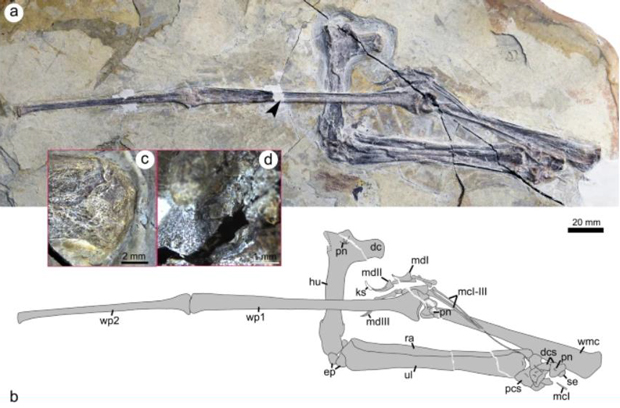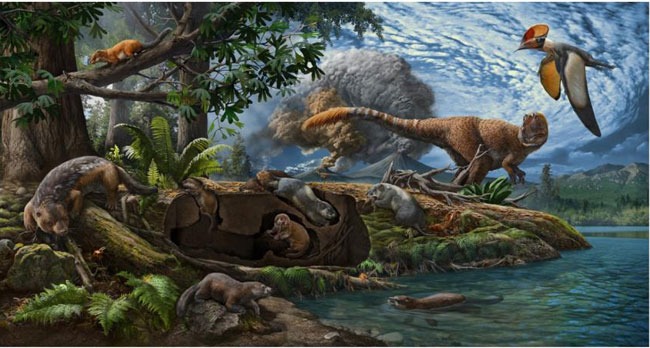New Analysis of Pterosaur Wing Suggests Jehol Biota Represents Migratory Area
A cross-sectional analysis of a pterosaur wing bone has helped palaeontologists to work out the ages and growth stages of flying reptiles from the Early Cretaceous Jiufotang Formation of China. This research suggests that the Jehol tapejarid biota represents a migratory area for these pterosaurs.
Writing in the academic journal “Scientific Reports”, researchers from Shandong University of Science and Technology (China) in collaboration with the University of Birmingham, took a tiny cross section of bone from the left forelimb of a pterosaur specimen assigned to the genus Sinopterus. Detailed analysis of the bone structure revealed that the fossil came from an immature individual at a late juvenile stage prior to reaching sexual maturity. This is the first time that histological data about the growth stages of Jehol tapejarids has been undertaken and based on this study, the largest skeletally immature tapejarid individuals recorded from the Jiufotang Formation might have reached sexual maturity.

The Jehol tapejarid Sinopterus (specimen number SDUST-V1014). Photograph (a) and line drawing (b) of the wing skeleton as well as enlarged images of the deltopectoral crest (c) and pneumatic foramen on the distal end of the wing metacarpal (d). Arrow points to the thin-section sample position on the first wing phalanx. Note scale bar for a and b = 20 mm. Picture credit: Zhou et al.
Picture credit: Zhou et al
At Least a Year Old
Microscopic analysis of the internal structure of the bone revealed the presence of one line of arrested growth (LAG) suggesting that this specimen was over a year old when it died. Palaeontologists have proposed that pterosaurs had a remarkably fast growth rate in their first three years and the postulated size of the pterosaur based on SDUST-V1014 fits with this hypothesis.
The Jehol biota relating to the Pterosauria is dominated by immature individuals and skeletally mature adults are exceptionally rare. The researchers postulate that this ecosystem was not home to the adults, that they may have lived apart from juveniles and immature animals. Perhaps this part of northern China was on a migratory route for these types of flying reptiles.
Picture credit: Chuang Zhao
Improving Our Knowledge of Tapejarid Anatomy
Although crushed, the forelimb bones reveal helpful morphological information clarifying the anatomy of Jehol tapejarids and the researchers suggest that this improved understanding could lead to a revision of the taxa associated with the Jiufotang Formation.
In addition, this histological analysis permits comparison with other pterosaur growth rates and the researchers conclude that the size gap between sexual and skeletal maturity in tapejarids was very similar to that observed in the not very closely related Pteranodon genus (Ornithocheiroidea).
To read a related article published in 2021 that examines the significance of a headless Sinopterus specimen (S. dongi) and its role in helping to define juvenile tapejarids: Headless Pterosaur Helps to Define an Entire Genus.
The scientific paper: “A new wing skeleton of the Jehol tapejarid Sinopterus and its implications for ontogeny and paleoecology of the Tapejaridae” by Chang-Fu Zhou, Dongxiang Yu, Ziheng Zhu and Brian Andres published in scientific reports.
The Everything Dinosaur website: Dinosaur Toys.


